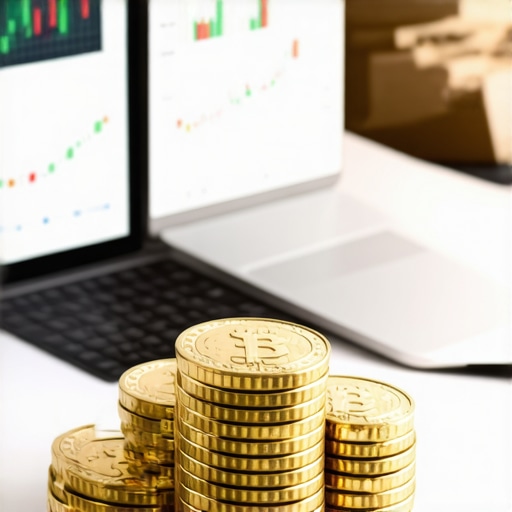Unlocking the Gold Futures Market: A Gateway to Strategic Trading
Gold futures offer a compelling avenue for traders seeking exposure to the precious metals market without the need to physically own gold. This financial instrument allows participants to speculate on the future price of gold, leveraging contracts standardized by exchanges such as the COMEX. Yet, diving into gold futures requires a nuanced understanding of both the lucrative opportunities and inherent risks that define this dynamic market.
Decoding the Mechanics: How Gold Futures Operate Beyond the Surface
At its core, a gold futures contract obligates the buyer to purchase—and the seller to deliver—a specified quantity of gold at a predetermined price on a set future date. These contracts are typically for 100 troy ounces, making them significant in value and impact. Unlike physical gold investments, futures provide leverage, amplifying both potential gains and losses. Understanding margin requirements, contract specifications, and expiration cycles is essential for managing positions effectively.
What Are the Primary Risks Associated with Trading Gold Futures?
Gold futures trading is inherently volatile, influenced by geopolitical tensions, currency fluctuations, interest rate changes, and global economic indicators. Traders face risks such as market volatility, liquidity constraints, and the possibility of margin calls that can lead to substantial financial exposure. For example, a sudden spike in the U.S. dollar or an unexpected Federal Reserve policy shift can trigger rapid price swings that catch unprepared traders off guard.
Harnessing Rewards: Strategic Advantages for Informed Traders
Despite the risks, gold futures can be a powerful tool for hedging inflationary pressures and diversifying portfolios. Their high liquidity and standardized nature enable swift entry and exit, facilitating tactical responses to market movements. Experienced traders often employ sophisticated strategies such as spread trading and technical analysis to capitalize on short-term price trends. Moreover, futures can serve as a cost-effective alternative to holding physical gold, avoiding storage and insurance expenses.
Expert Insights: Integrating Gold Futures into a Balanced Investment Strategy
Seasoned investors often combine gold futures with other investment vehicles to mitigate risk and optimize returns. For instance, pairing futures with physical gold or gold ETFs can provide a balanced exposure to both price appreciation and tangible asset security. According to the CME Group, understanding market fundamentals and maintaining disciplined risk management protocols are critical to successful futures trading.
To deepen your expertise on gold trading techniques and market volatility, explore our detailed guide on gold trading strategies and stay ahead in this ever-evolving landscape.
Engage and Expand: Share Your Experiences and Learn from Fellow Traders
Have you navigated the complexities of gold futures trading? Share your insights, strategies, or challenges in the comments below to foster a community of informed traders. Your unique perspective could illuminate new paths for others exploring this intricate market.
Personal Reflections on Managing Gold Futures Risks
From my own experience, one of the most challenging aspects of trading gold futures has been controlling emotional reactions during sudden market swings. I remember a time when geopolitical unrest caused gold prices to jump overnight, triggering margin calls that I hadn’t fully anticipated. It was a tough lesson on the importance of not over-leveraging and maintaining strict stop-loss orders. These experiences highlight why education and preparation are key before diving deep into futures contracts.
Blending Futures with Other Gold Investments: Finding the Right Balance
Over the years, I’ve found that integrating gold futures with physical gold holdings or gold ETFs offers a more stable investment approach. Physical gold provides that tangible sense of security, while ETFs offer liquidity and ease of trading. Futures, on the other hand, can complement these by providing opportunities for tactical positioning and hedging. This layering not only diversifies risk but also allows for flexibility in responding to market conditions. If you want to explore this balanced approach, you might find our guide on choosing between gold coins, bars, and ETFs quite insightful.
How Can Novice Traders Build Confidence Before Trading Gold Futures?
It’s natural to wonder how to gain confidence when starting with such a complex instrument. For me, simulated trading platforms were invaluable. They let me test strategies without risking capital, helping me understand market rhythms and margin mechanics. Also, surrounding yourself with reliable resources and communities can accelerate learning. According to a report by the Investopedia team, combining theoretical knowledge with practical experience is crucial for mastering futures trading.
Another tip is to start small. Begin with fewer contracts to limit exposure while you build your skill set. Remember, patience and discipline often trump impulsiveness in this arena.
Practical Tips for Staying Ahead in Gold Futures Trading
One strategy I swear by is keeping a trading journal. Documenting every trade, the rationale behind it, and the outcome helps identify patterns in both the market and my own decision-making. This practice has sharpened my ability to spot opportunities and avoid repeating mistakes.
Additionally, staying informed about global economic indicators is non-negotiable. Factors like Federal Reserve announcements, inflation data, and currency strength directly affect gold prices. I regularly review market updates and analyses from trusted sources to align my trades with broader trends.
If you’re intrigued by the nuances of gold market behavior, our article on what drives gold price movements offers a great deep dive.
Join the Conversation: What’s Your Gold Futures Trading Story?
I’d love to hear about your experiences with gold futures — whether you’re just starting or you’ve been trading for years. What strategies have worked for you? What lessons did you learn the hard way? Please share your stories in the comments below. Engaging with fellow traders not only builds community but also enriches our collective understanding.
Innovative Risk Mitigation Strategies: Beyond Basic Stop-Loss in Gold Futures
While stop-loss orders are foundational in managing downside risk, advanced traders often layer these with more sophisticated techniques to protect capital in the volatile gold futures arena. One such method involves the use of trailing stops, which adjust dynamically as the market moves in your favor, locking in profits while still allowing room for upside potential. Additionally, integrating options overlays can serve as effective hedges against adverse price movements, providing a safety net without completely capping upside.
Another nuanced approach is employing position sizing algorithms driven by volatility metrics such as the Average True Range (ATR). By adjusting contract sizes in response to changing market volatility, traders can maintain consistent risk exposure even during turbulent times. This dynamic sizing is particularly pertinent in gold futures, where geopolitical events or macroeconomic data releases can cause abrupt price swings.
What Are the Cutting-Edge Tools for Real-Time Gold Futures Risk Assessment?
Modern technology has empowered traders with real-time analytics that go far beyond traditional charting. Platforms now incorporate machine learning models capable of parsing vast datasets—ranging from economic indicators to sentiment analysis of news feeds—to predict short-term price movements and volatility spikes. For example, the integration of machine learning in futures trading by CME Group highlights how algorithms can enhance decision-making by identifying complex patterns invisible to the human eye.
Furthermore, real-time risk dashboards aggregate exposure metrics, margin requirements, and potential scenario outcomes, enabling traders to promptly adjust strategies before market conditions deteriorate. This granular visibility is indispensable for managing the leverage inherent in futures contracts.
Leveraging Macroeconomic Indicators: An Expert’s Guide to Gold Price Forecasting
Gold prices are intricately tied to global economic currents. Advanced traders monitor a constellation of indicators—beyond the obvious inflation reports and Federal Reserve announcements—to anticipate market shifts. For instance, the interplay between real interest rates and currency strength often dictates gold’s directional bias.
Consider the real yield, which adjusts nominal interest rates for inflation expectations. When real yields fall, gold typically gains appeal as an alternative store of value. Conversely, rising real yields can depress gold prices as the opportunity cost of holding non-yielding assets increases. Incorporating this into a trading model requires synthesizing data from Treasury Inflation-Protected Securities (TIPS) and inflation forecasts.
Currency dynamics, particularly involving the U.S. dollar, add another layer of complexity. Since gold is priced in dollars globally, a strengthening dollar usually exerts downward pressure on gold prices and vice versa. However, this relationship can be nuanced by regional economic policies and geopolitical developments, necessitating a multifaceted analytical approach.
How Do Global Geopolitical Risks Quantitatively Affect Gold Futures Volatility?
Quantifying geopolitical risk is notoriously challenging, but innovative methodologies have emerged to approximate its impact on gold futures. One approach involves utilizing the Geopolitical Risk Index (GPR), which aggregates news-based data to gauge the intensity of geopolitical tensions. Studies have demonstrated a statistically significant correlation between spikes in the GPR and increased gold price volatility, affirming gold’s role as a safe-haven asset during crises.
Moreover, volatility modeling techniques such as GARCH (Generalized Autoregressive Conditional Heteroskedasticity) can incorporate GPR data as an exogenous variable, enhancing the predictive power for price swings. This fusion of econometric modeling and geopolitical data equips traders with a more quantitative framework to anticipate and navigate sudden market turbulence.
For an in-depth exploration of these models and their application, the Journal of Empirical Finance provides a comprehensive analysis.
Encouraging Deeper Mastery: Expand Your Gold Futures Trading Arsenal
The terrain of gold futures trading is ever-evolving, blending economic theory, quantitative analysis, and behavioral insight. I invite you to delve further into these advanced concepts and hone your edge by exploring our upcoming masterclass series, which will cover algorithmic strategies, real-time risk management tools, and macroeconomic modeling tailored specifically for gold futures.
Engage with fellow experts, test your strategies in simulated environments, and elevate your trading acumen to new heights. Stay tuned for exclusive content designed to transform your approach from reactive to anticipatory in this complex market.
Integrating Quantitative Models for Enhanced Gold Futures Strategies
Moving beyond traditional analysis, quantitative modeling offers traders a sophisticated toolkit to dissect gold futures price dynamics. Techniques such as time-series forecasting and machine learning-driven pattern recognition enable the extraction of nuanced signals from complex datasets encompassing price history, macroeconomic indicators, and geopolitical sentiment. Leveraging these models can refine entry and exit timing, optimize hedging strategies, and enhance portfolio resilience against volatility shocks.
How Can Algorithmic Trading Improve Execution and Risk Control in Gold Futures?
Algorithmic trading systems, designed with adaptive parameters and real-time data integration, can automate trade execution based on predefined risk thresholds and predictive analytics. By systematically responding to market microstructure signals and volatility regimes, these systems minimize human biases and latency, crucial in the fast-moving gold futures market. Incorporating features such as dynamic stop-loss adjustments and position rebalancing algorithms allows for precision risk management aligned with evolving market conditions.
Harnessing Sentiment Analysis and Alternative Data Streams for Market Edge
Beyond conventional economic data, alternative datasets—like social media sentiment, news feed analytics, and commodity-specific sentiment indices—provide leading indicators of market psychology that precede price movements. Utilizing natural language processing (NLP) techniques to quantify sentiment polarity and intensity can expose latent investor biases or emerging trends, offering traders a competitive advantage when integrated into comprehensive trading frameworks.
According to research published by the CME Group, the fusion of sentiment analytics with price action data enhances the robustness of predictive models, enabling more informed decision-making under uncertainty.
Advanced Portfolio Construction: Synergizing Gold Futures with Diverse Asset Classes
Incorporating gold futures into a multi-asset portfolio requires nuanced correlation and volatility analysis to maximize diversification benefits. Employing techniques like mean-variance optimization and stress testing under extreme market scenarios helps quantify the incremental risk-return profile contributed by gold futures. Strategic allocation calibrated to macroeconomic cycles and risk appetite can bolster downside protection while preserving upside potential.
Elevate Your Trading Mastery: Engage with Cutting-Edge Tools and Communities
To truly capitalize on these advanced insights, immerse yourself in platforms offering real-time analytics, algorithmic backtesting, and collaborative expert forums. Our upcoming masterclass series will delve deeper into these themes, equipping you with actionable methodologies and peer support to refine your gold futures trading acumen.
Explore the frontiers of quantitative and sentiment-driven trading strategies today—join our community and access exclusive resources designed to transform your approach from reactive to anticipatory in the gold futures arena.
Frequently Asked Questions (FAQ)
What distinguishes gold futures trading from investing in physical gold or gold ETFs?
Gold futures contracts are standardized agreements to buy or sell a specific quantity of gold at a predetermined price and date, offering leverage and liquidity advantages but also higher risk and complexity. Physical gold provides direct ownership and tangible asset security, while ETFs offer liquid exposure with fractional shares and lower entry costs. Futures are ideal for tactical trading and hedging, whereas physical gold and ETFs suit long-term holding and portfolio diversification.
How do margin requirements influence risk management in gold futures?
Margin requirements represent the collateral traders must post to open and maintain futures positions, acting as a performance bond. They amplify both gains and losses, making adequate capital and strict risk controls essential. Insufficient margin can trigger margin calls, forcing liquidation at unfavorable prices. Understanding initial and maintenance margins helps traders size positions appropriately and avoid unexpected financial strain.
Can algorithmic trading reliably improve gold futures trading outcomes?
Algorithmic trading can enhance execution speed, reduce emotional bias, and systematically manage risk by using pre-set rules and real-time data. When properly designed with adaptive parameters and integrated risk controls, algorithms can identify patterns and optimize entry/exit points. However, they require ongoing monitoring, robust backtesting, and adjustment to evolving market conditions to maintain effectiveness in the volatile gold futures environment.
What macroeconomic indicators should traders monitor to forecast gold price movements?
Key indicators include real interest rates (nominal rates adjusted for inflation), Federal Reserve monetary policy signals, inflation data, currency strength—especially the U.S. dollar—and geopolitical risk indices. These factors influence gold’s appeal as a hedge and safe haven, affecting demand and price volatility. Sophisticated traders synthesize these complex variables to anticipate directional biases and volatility shifts.
How can traders quantify and incorporate geopolitical risk into their gold futures strategies?
Traders use tools like the Geopolitical Risk Index (GPR) which aggregates news-based data reflecting global tensions. Incorporating GPR into volatility models such as GARCH allows quantitative assessment of geopolitical impacts on gold price fluctuations. This integration equips traders to preemptively adjust exposure during periods of heightened uncertainty, leveraging gold’s historical role as a crisis hedge.
What are effective risk mitigation strategies beyond basic stop-loss orders in gold futures?
Advanced approaches include trailing stops that dynamically lock in profits, options overlays for hedging downside while preserving upside, and volatility-driven position sizing algorithms. These techniques adapt to changing market conditions and help protect capital during sudden swings. Combining multiple layers of protection enhances resilience against unpredictable gold futures market movements.
How does sentiment analysis contribute to gold futures trading decisions?
Sentiment analysis utilizes natural language processing to quantify market psychology from news, social media, and specialized sentiment indices. By detecting shifts in investor mood or emerging trends ahead of price changes, traders gain a leading edge. Integrating sentiment data with traditional price and volume analysis enriches predictive accuracy and informs timing and sizing of trades.
What is the role of portfolio construction techniques when integrating gold futures with other asset classes?
Portfolio construction methods like mean-variance optimization and stress testing quantify how gold futures affect overall risk-return tradeoffs. Gold futures often exhibit low or negative correlations with equities and bonds, enhancing diversification. Strategic allocation calibrated to macroeconomic cycles and individual risk tolerance can improve downside protection and capital preservation while maintaining growth potential.
How can novice traders build confidence before actively trading gold futures?
Starting with simulated trading platforms allows beginners to practice without financial risk, understand margin mechanics, and test strategies. Complementing practical experience with rigorous study of contract specifications, market fundamentals, and risk management is vital. Beginning with small positions and cultivating patience and discipline fosters steady skill development and reduces emotional exposure.
What technological tools are currently shaping the future of gold futures trading?
Emerging technologies include machine learning algorithms that detect complex market patterns, real-time risk dashboards aggregating exposure metrics, and advanced backtesting platforms enabling strategy refinement. Integration of alternative data sources such as sentiment analytics and geopolitical indices further enhance decision-making. These innovations empower traders to anticipate market moves and manage leverage more effectively.
Trusted External Sources
- CME Group (https://www.cmegroup.com/): As the primary exchange for gold futures, CME Group provides comprehensive contract specifications, real-time market data, educational resources, and insights into technological advancements in futures trading.
- Investopedia (https://www.investopedia.com/): Offers clear, expert-reviewed explanations of gold futures concepts, risk management techniques, and practical trading advice valuable for both beginners and advanced traders.
- Journal of Empirical Finance (https://www.jstor.org/stable/41682884): Publishes rigorous academic research on the quantitative impacts of geopolitical risk and econometric modeling of commodity price volatility, deepening understanding of gold futures dynamics.
- Federal Reserve Economic Data (FRED) (https://fred.stlouisfed.org/): Supplies authoritative macroeconomic indicators including real interest rates, inflation metrics, and monetary policy data essential for forecasting gold price movements.
- CME Group Education Articles (https://www.cmegroup.com/education/articles-and-reports/): Focused analyses on machine learning applications and sentiment analytics in futures trading, showcasing cutting-edge tools and methodologies for market participants.
Conclusion
Gold futures trading represents a sophisticated intersection of leverage, market dynamics, and strategic opportunity within the precious metals arena. Mastery requires more than surface-level knowledge; it demands a deep comprehension of contract mechanics, rigorous risk management, and an ability to interpret macroeconomic and geopolitical signals that influence gold prices. Incorporating quantitative models, sentiment analysis, and algorithmic tools can significantly refine trading precision and resilience.
A well-rounded approach that balances futures with physical gold and ETFs can optimize portfolio diversification and mitigate risk. Novice traders benefit from immersive practice and disciplined learning, while seasoned professionals thrive by integrating advanced analytics and continuous market engagement.
By embracing these expert insights and leveraging trusted resources, traders can transform their gold futures strategies from reactive speculation into informed anticipation, unlocking the market’s full potential. Share your thoughts, experiences, and questions below—let’s advance collective expertise and navigate the complexities of gold futures trading together.










I’ve found the article’s focus on risk management in gold futures particularly resonant. Trading gold futures certainly opens doors to profitable opportunities, especially given their leverage and liquidity. However, it’s a double-edged sword—market volatility driven by geopolitical events or sudden shifts in interest rates can quickly turn a promising position sour. From my experience, one overlooked challenge is properly calibrating margin requirements to avoid unexpected margin calls during volatile periods. The article’s insights on layering stop-loss orders with dynamic position sizing algorithms and options overlays struck a chord. These advanced approaches have helped me maintain steadier control in choppy markets. I’m curious how other traders balance the allure of leverage with the discipline needed for risk control. Do any readers use specific algorithmic tools or sentiment analysis platforms to get ahead of sudden price swings in gold futures? Also, for those integrating futures with physical gold or ETFs, how do you determine the ideal portfolio ratio to optimize both safety and tactical flexibility? It’s a fascinating balancing act that I believe warrants more community discussion, especially for traders looking to deepen their strategic edge.